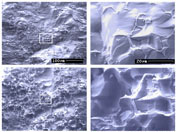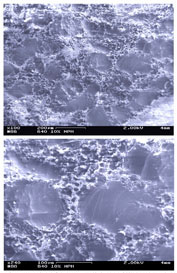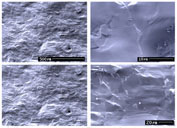In MPH-rich regions (as you'll see in photos of all the different samples I looked at) the ice sublimates extremely fast, giving a somewhat false impression of how much MPH is there. When I first look at these sections they look like they're entirely ice, then the sample literally changes in front of my eyes as the ice sublimates, recedes, and exposes the MPH. You can get a good sense of that in the time-lapse images shown here. In the first compilation shown below (composite_1), note that the right-hand images are the exact same spot, just 20 minutes apart!
In ice-rich sections though, the ice stays extremely stable in the SEM and there's almost no change with time (at least almost no change over an hour time.)
(I still find the various sublimations effects that depend on what phases are paired together to be extremely interesting. Ice is very stable under the beam when by itself or paired with gas hydrate, but behaves entirely differently with MPH, salt hydrates, Mg or Na sulfate hydrates, etc.)
640 had regions that were obviously MPH or ice-rich, and the compilations here show both.
The MPH, by the way, on close view, looks dense at first appearance and then develops the pits and pores as it is exposed in the SEM column.


